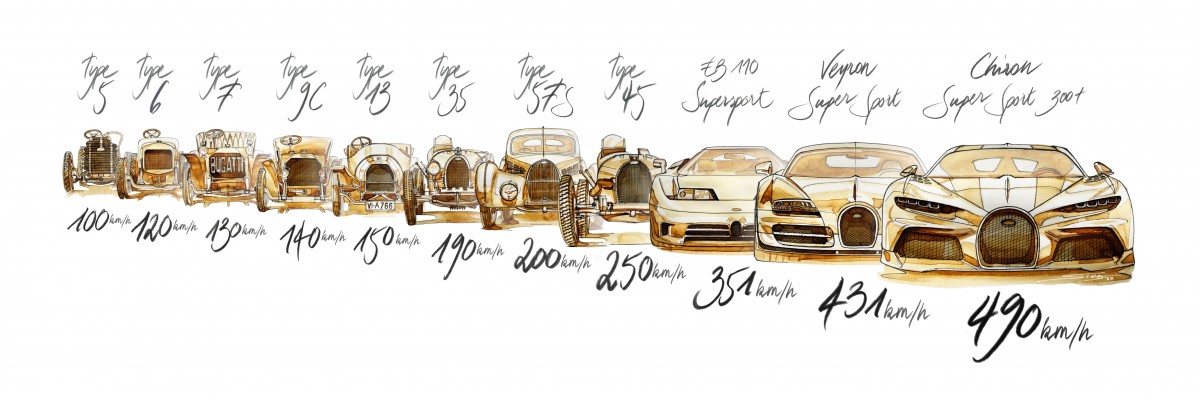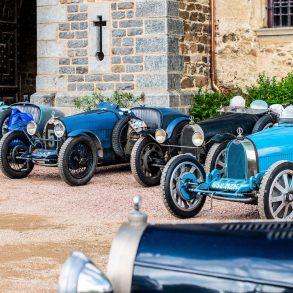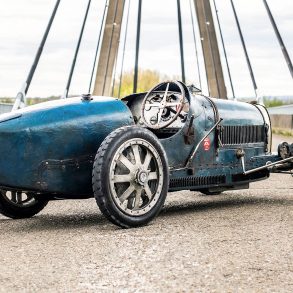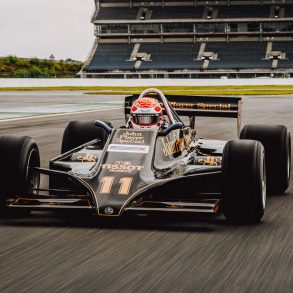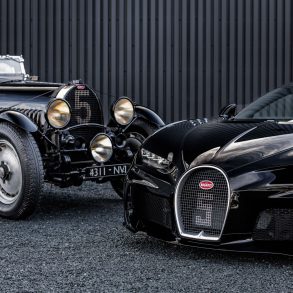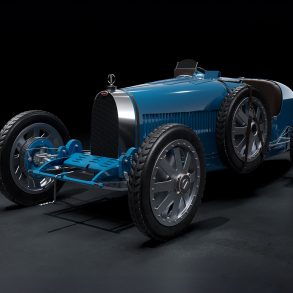Back in the summer of 2019 Bugatti did what was once thought impossible- the Bugatti Chiron Super Sport 300+ recorded 304.77 miles per hour on its speedometer and smashed the previous record.
Driving the Chiron Super Sport 300+, Bugatti became the first manufacturer to break the 300-mph barrier, proving once again Bugatti’s outstanding performance. Although this achievement is unprecedented, it was not the first record to be broken by Bugatti. Bugatti is a brand of superlatives and has been a leader in automotive engineering for more than 110 years, with Ettore Bugatti as its inventive designer.
Breaking 100km/hr
In 1903, the De Dietrich 60 CV Course Bugatti Type 5 was able to produce a speed of more than 100 kmh.

The car was designed and developed by Ettore Bugatti himself, and it was powered by a four-cylinder engine (12.85 liter capacity) with one ignition coil in each combustion chamber, overhead valves, and hopper cooling. With a top speed of 120km/h, Bugatti only produced two of the racing cars in two years.
Breaking 120 km/h
Just a year later, in 1904, Ettore Bugatti and Émile Mathis, under the name of the newly founded Hermes-Simplex company, teamed up to create the 40/50 PS model. It had a 7.5-liter, four-cylinder engine and could produce speeds of more than 120km/h. They were produced at Société Alsacienne de Construction Mécanique in Graffenstaden (SACM) and were used to compete in many races.
Breaking 130 km/h
From 1904 to 1906, the development of the 50/60 PS models by Hermes-Simplex was led by Ettore Bugatti. The models were available in two variants, either an 8.5-liter four-cylinder engine or an almost 9.0-liter four-cylinder engine. It was not long before a newer, more powerful model was released, the 80/90 PS, which had a 12-liter four-cylinder engine and could reach speeds of more than 130 km/h.
Breaking 140 km/h
Following Émile Mathis leaving Hermes-Simplex, Ettore Bugatti relocated to Gasmotorenfabrik Deutz AG in Cologne. In Cologne during the years 1906 until 1909, there were several prototypes were constructed in parallel with a racing car with a 1.3-litre capacity.
The Bugatti Deutz Prinz Heinrich Type 9 C was designed by Bugatti in 1909 at Deutz which had the capability of reaching more than 140km/h. It made its debut at the Prinz-Heinrich-Fahrt, a 1,850 kilometer endurance race for four-seater touring cars.
Breaking 150 km/h
Ettore Bugatti founded his own brand in 1909, and just a year after, he returned to the Prinz-Heinrich-Fahrt to compete again. He brought the Bugatti Type 13, a 1.4-liter, four-cylinder engine with four-valve technology. It had a top speed of more than 150km/h, with an average speed of 142.6 km/h.

Bugatti continuing building and improving the Type 13, which only weighed 300kg, until 1920. Bugatti produced more than 400 units of the practically unbeatable racing car.
Breaking 200 km/h
When Bugatti launched the Type 35, they unleashed a completely new race car. It had an eight-cylinder engine with a 2.0-liter capacity delivering 95 PS and speeds up to 190 km/h.

It wasn’t long before the Type 35 B was presented to the world. It had a 2.3-liter capacity and a compressor allowing it to generate more power. With 140 PS, the car was able to deliver an impressive 215km/h.

The Type 35 won more than 2,000 races in the following years, making the Bugatti Type 35 the most successful racing car of all time.
By 1934, Bugatti has successfully designed the Type 57 S, a sports car that was made exclusively for road use which was able to surpass the 200km/h mark.

Breaking 250 km/h
In 1929, Bugatti launched an exceptional racing car, the Type 45. Two parallel eight-cylinder engines were combined, creating a 16-cylinder engine for cars. The 3.8-liter engine produced 270 PS at 5,000 rpm, reaching speeds over 250 km/h. The car was utilized for short-distance and hill races, and not endurance races as the tires weren’t able to cope with the high speeds over a long period of time. In all, only two vehicles were constructed.
Breaking 300 Km/h
In as early as 1929, Ettore Bugatti was already trying to conceive of a way to build a roadworthy high-speed car that could break the 300km/h barrier. Technical drawings and sketches from Bugatti showed that he had already thought of combining an eight-cylinder in-line engine from the Type 41 Royale and pairing it with a Type 50 gearbox. Although he had figured out that theoretically, his ideas could deliver the target speed that he wanted, the project was set aside due to budget constraints.
The number would not be broken by Bugatti for decades until Romano Artioli took up the challenge.
The Bugatti trademark was sold to Artioli in 1987 where he commenced building a super sports cars known as the EB110. It had a 3.5-liter, V12 mid-engine, with five valves in each combustion chamber.

In 1992, the EB110 broke the 300km/h mark as it set an impressive maximum speed record of 342kph. The output generated by the EB110 differed depending on the development stage and the model, which were between the 560 PS for the GT and 610 PS in the Supersport (SS).
Breaking 350 km/h
A year later, an EB110 SS, chassis 008, with a power output of 610 PS, broke the 350 km/h mark, recording a top speed of 351kph.

Breaking 400 km/h
It took more than 15 years – 2005 to be precise before Bugatti Veyron broke past the 400km/h mark.

The Bugatti Veyron was the first hyper sports car from the 2000s to achieve this feat. Under the hood of the Veyron is an 8.0-liter, 16-cylinder engine that can produce 1,001PS. At the time, the Veyron was considered the fastest series-production sports car in the world. The Veyron has a second key which was known as the Speed Key. Drivers would need to activate the Speed Key to achieve speeds of more than 400kph.

Fast forward 5 years and the Bugatti Veyron 16.4 Super Sport was released on June 26, 2010 where Bugatti once again broke speed records for a road-approved super sports cars. Under the watchful eyes of the Guinness World Records as well as the German TÜV, the Super Sport recorded a top speed of 431.072kph, replacing the Bugatti Veyron as the fastest series-production sports car in the world.

Another record was broken in 2013 when the open-top Bugatti Veyron 16.4 Grand Sport Vitesse became the world’s fastest road-approved roadster clocking speeds at 408.84kph.
Breaking 490 km/h
Despite competitors not breaking or even matching the records they had already set, in the summer of 2019, the Bugatti Chiron Super Sport 300+ raised the bar even higher.

The Molsheim produced hyper sports car logged a speed of 304.773mph, which is 490.484kph. The 8.0-liter W16 engine with a 1,600 PS power output became the first series-production car to break the 300mph barrier.
Breaking over 500 km/h
In October 2020, Bugatti again had something for the speed junkies as they launched the Bolide hyper sports car, an extreme track-oriented vehicle. Under the hood of the Bolide is an 8.0-liter W16 engine with a 1,850 PS power output. Bugatti gave the Bolide a minimalist body that weighs only 1,240 kilograms, including the engine. The weight to power ratio of the Bolide is a remarkable 0.67 kilograms per PS.

The experimental research of the Bolide produces a simulated maximum speed that clears 500 km/h while still delivering maximum handling and the highest agility. This makes the Bolide the first Bugatti that can possibly achieve speeds that break the 500 km/h barrier.
“In recent decades, Bugatti has shown that we build the fastest and most exclusive vehicles in the world. We are very proud of our history. However, we don’t just define ourselves by records or maximum speeds.”
Stephen Winkelmann
Bugatti hyper sports car are more than just record-breaking speeds. Fans are hooked because Bugatti offers luxury, unparalleled performance, design, exclusivity, and automotive hand craftsmanship.
[Source: Bugatti]


